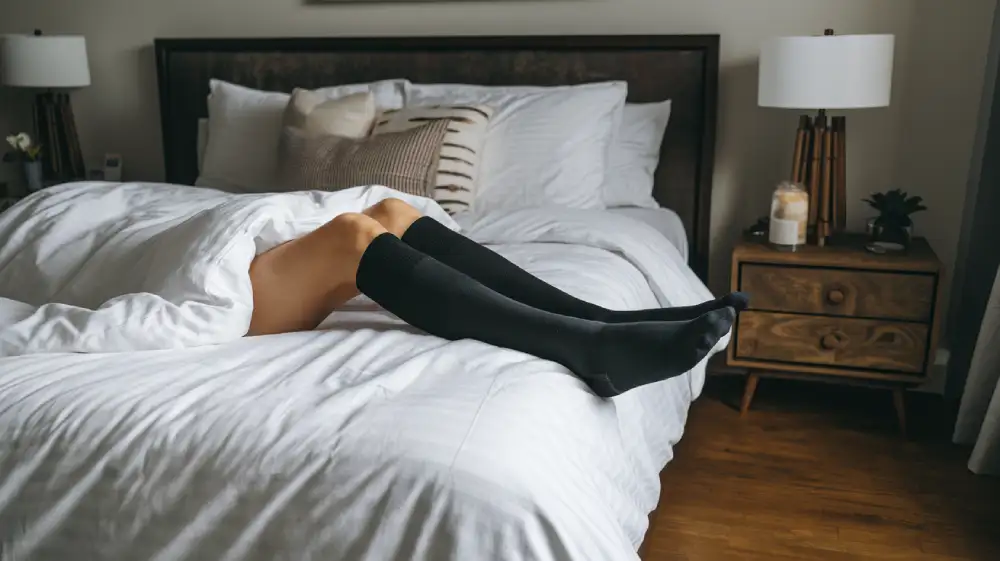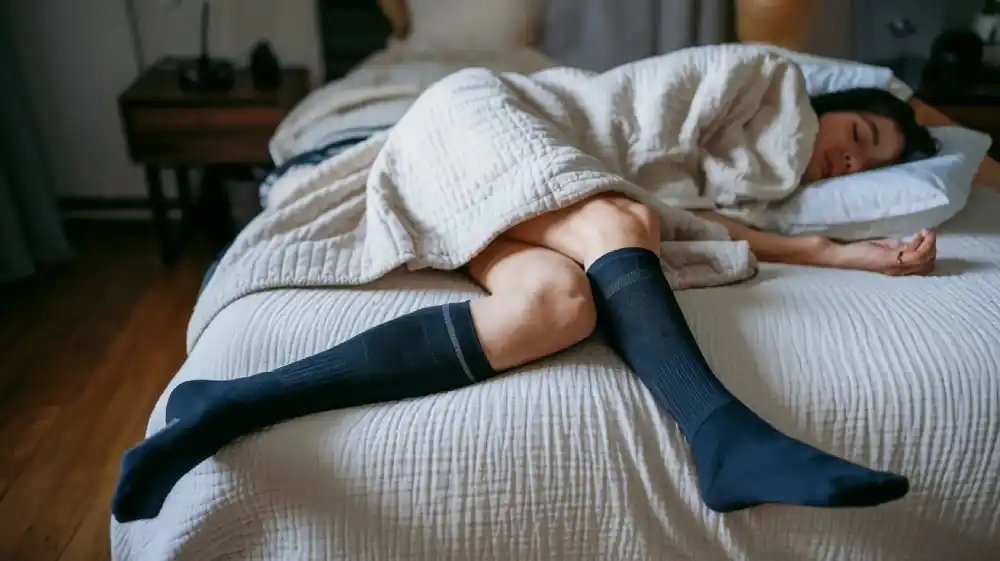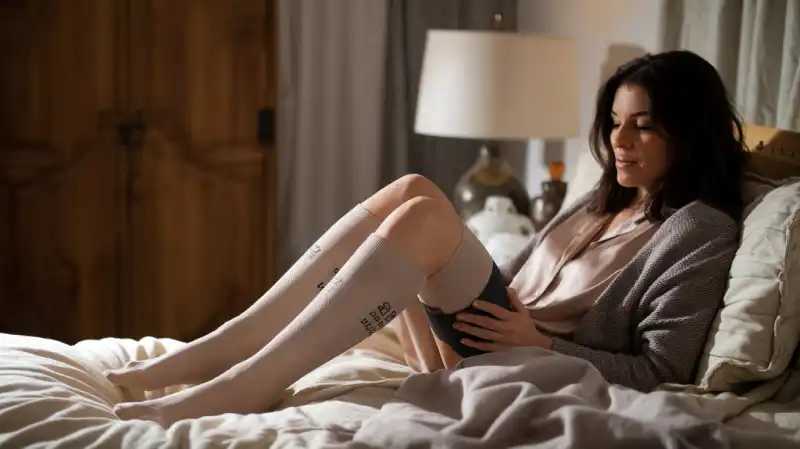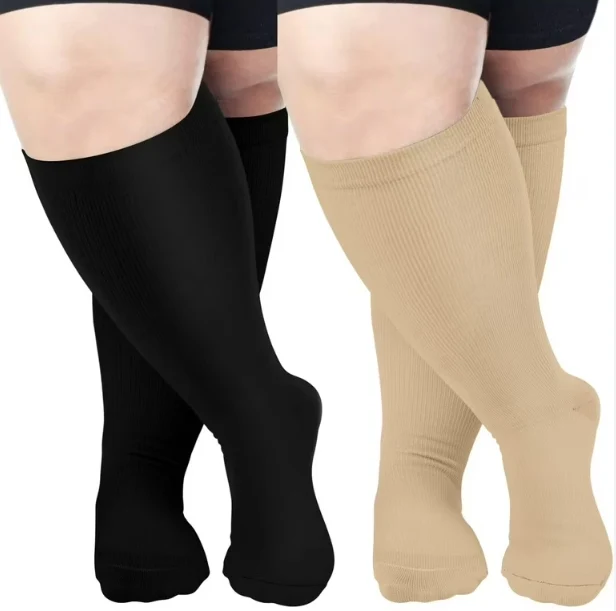Introduction: Why Retailers Must Master Nighttime Compression Socks Knowledge
As a retailer, staying ahead of customer demands is crucial—especially when it comes to products like compression socks. The growing trend of wearing compression socks around the clock means that your customers are increasingly asking, “Can I wear these at night?” Understanding the full scope of benefits and potential risks will not only help you answer these questions but will also position your brand as a trusted authority. The right knowledge can elevate your credibility and build stronger relationships with your customers, ultimately driving sales and fostering loyalty.
In this guide, we’ll break down everything you need to know about nighttime compression wear, helping you provide valuable insights that solve real problems for your clients while setting your business apart.

What Are Compression Socks and How Do They Help?
Compression socks apply gentle pressure to your legs, improving blood flow and helping to reduce swelling and discomfort. They are designed to be tighter around the ankle and looser as they go up the leg, which helps push blood back toward the heart, making circulation more efficient.
- Help Blood Circulation: By gently squeezing the legs, compression socks help blood flow upward, preventing it from pooling in the lower legs. This improved circulation can reduce swelling and provide relief for tired or heavy legs.
- Effects on Chronic Venous Insufficiency, Swelling, and Pain: For people with venous issues or swelling, wearing compression socks can be beneficial. They reduce the pressure in the veins, improving blood flow and easing pain, making them especially useful for individuals with conditions like varicose veins.
- Benefits for Athletic Recovery and Muscle Performance: Compression socks aren’t just for medical use—they’re also popular among athletes. After a workout, they help reduce muscle soreness and speed up recovery by improving blood flow and reducing muscle fatigue.
Can Compression Socks Be Worn Overnight?
Wearing compression socks overnight can be helpful in certain situations, but it isn’t necessary for everyone. Whether or not they should be worn while sleeping depends on the individual’s health condition and needs.
Circumstances Where Wearing Compression Socks Overnight Is Beneficial
For people dealing with conditions like chronic venous insufficiency, lymphedema, or severe edema, wearing compression socks at night can support blood flow and reduce swelling. Additionally, they can be helpful for post-surgical recovery, promoting healing and improving circulation while the body rests.
When Wearing Compression Socks at Night May Not Be Necessary
For healthy individuals, wearing compression socks while sleeping isn’t typically required. The body naturally helps blood circulate when lying down, so there’s no need for extra pressure. In fact, for many, wearing them overnight can lead to discomfort or even skin irritation if they’re too tight or made of non-breathable materials.

Importance of Consulting a Doctor Before Recommending Nighttime Wear
It’s important to advise customers to consult with a doctor before wearing compression socks overnight, especially for those with underlying health conditions like diabetes, peripheral artery disease, or skin issues. A healthcare professional can recommend the appropriate use of compression socks based on an individual’s specific needs and health status.
Benefits of Wearing Compression Socks While Sleeping
Wearing compression socks at night can offer several health benefits, especially for individuals dealing with specific conditions or recovery needs.
Supporting Wound Healing for Individuals with Venous Disease
For those with venous disease or leg ulcers, compression socks help improve blood circulation and reduce pressure in the veins. This can aid in faster wound healing and reduce the risk of complications, allowing individuals to heal more efficiently while they sleep.
Reducing Swelling and Promoting Blood Flow in Post-Surgical Recovery
After surgery, swelling and poor circulation can slow down the healing process. Compression socks help by applying consistent pressure, reducing fluid buildup, and improving blood flow. This aids in a quicker recovery, allowing the body to heal while the individual rests overnight.

Preventing Dizziness in People with Postural Hypotension
Postural hypotension, or low blood pressure upon standing, can cause dizziness or fainting. Wearing compression socks overnight can help prevent this by maintaining better blood flow to the heart and brain, reducing the chances of sudden drops in blood pressure when standing up in the morning.
Enhancing Recovery for Athletes After Exercise
Compression socks are also beneficial for athletes. After intense physical activity, wearing them overnight can help reduce muscle soreness and speed up recovery. By improving blood circulation and reducing muscle fatigue, they allow athletes to recover faster and feel more refreshed the next day.
Potential Risks of Wearing Compression Socks While Sleeping
While compression socks can be beneficial for certain individuals, wearing them overnight may not always be suitable. It’s important to understand the potential risks involved for some users.
Inconvenience for Healthy Individuals Without Circulatory Issues
For people without circulatory problems, wearing compression socks at night may not provide significant benefits. The body already naturally supports blood circulation while lying down, and adding compression may simply cause discomfort without improving circulation or reducing swelling.
Risks of Tightness, Discomfort, and Impaired Skin Respiration
Wearing compression socks that are too tight or poorly fitted can lead to discomfort, skin irritation, and restricted blood flow. If the material isn’t breathable, it can cause skin to become damp and irritated, disrupting sleep quality and increasing the risk of discomfort.
Possible Increase in Fungal Infections
Long-term use of compression socks without proper care, such as not ensuring they are dry or made from breathable fabrics, can increase the risk of fungal infections. Moisture trapped in the socks can create an environment where bacteria and fungi can grow, which is especially concerning for individuals with sensitive skin.
Caution for People with Diabetes, Arterial Disease, or Circulation Problems
For individuals with diabetes, peripheral artery disease, or other circulatory conditions, wearing compression socks at night can have serious consequences. Improper fit or excessive pressure can impair circulation, potentially worsening existing health issues. Always recommend consulting a healthcare professional before using compression socks for extended periods.
How to Choose the Right Compression Sock for Nighttime Use
When selecting compression socks for overnight use, it’s important to offer your customers the right options to ensure comfort, effectiveness, and safety. Here’s how to guide them in choosing the best fit.
Selecting the Appropriate Compression Level (15-20mmHg Recommended)
For most customers, compression socks with a 15-20mmHg level of pressure are ideal for nighttime use. This mild compression helps improve circulation without being too tight, providing comfort throughout the night. Higher compression levels are generally recommended only for specific medical conditions and should be suggested under the guidance of a healthcare professional.
Importance of Proper Fit Without Tightness
It’s essential that compression socks fit properly to avoid discomfort. They should be snug but not constricting. Socks that are too tight can hinder circulation and cause discomfort, leading to poor sleep. Ensuring a good fit with gradual compression from ankle to calf allows your customers to experience the benefits without the risks of overly tight socks.
Choosing Breathable and Moisture-Wicking Materials
To improve comfort during sleep, recommend compression socks made from breathable and moisture-wicking materials. Fabrics such as Sorbtek® yarn help keep the skin dry by drawing moisture away, reducing the risk of irritation and ensuring comfort throughout the night. Moisture management is key to avoiding skin issues or fungal growth, especially when worn for extended periods.
Customization Options for Comfort and Durability
Offering customizable options for compression socks allows you to cater to different customer preferences. You can adjust the fit, design, and even add special features like reinforced heels and toes for added durability. Customization not only ensures comfort but also increases the perceived value of the product, helping your customers get the most out of their compression socks.
Custom Compression Socks: Solving Nighttime Challenges
Designing for Medical & Lifestyle Nighttime Needs
Customized compression socks address two key nighttime challenges: medical support and comfort for everyday users. For example, breathable, antimicrobial fabrics prevent skin irritation during sleep, while ergonomic pressure gradients reduce swelling for patients with venous issues or sedentary lifestyles. Collaborating with a factory allows you to tailor features like moisture-wicking liners or adjustable calf widths, ensuring products meet diverse customer needs and stand out in a growing market.

How Custom Solutions Cut Returns & Boost Loyalty
Beyond standard sizing, custom compression socks can include wide-leg designs and extended size ranges (e.g., petite to plus sizes), solving fit issues that drive returns. For example, wide-leg options accommodate customers with muscular calves or edema, while extended sizes ensure inclusivity for diverse body types. By tailoring these features, brands directly address common sizing complaints—like mismatched calf and foot proportions.
High-Performance Materials for All-Night Wear
Nighttime socks demand fabrics that balance compression with comfort. Blends like nylon-spandex with cooling fibers keep skin dry, while seamless stitching eliminates friction for restless sleepers. Highlighting these details in product descriptions attracts both medical and lifestyle buyers.
Graded Pressure: The Science Behind Nighttime Support
Gradual compression (higher at the ankle, lower at the calf) mimics natural muscle movement, enhancing circulation without numbness. For brands, emphasizing this design appeals to health-conscious customers and aligns with clinical guidelines, boosting credibility.
Why Partner with Us for Custom Compression Socks?
- Specialized Craftsmanship in Night-Focused Designs
We combine FDA/CE-certified craftsmanship with sleep-specific innovations. For example, breathable, moisture-wicking fabrics and seamless toe closures reduce nighttime irritation, while ergonomic pressure mapping (15-20mmHg ankle, 8-10mmHg calf) ensures safety for extended wear. Our 20+ years of expertise let us address niche needs, like hybrid medical-athletic designs or eco-friendly material blends, giving your brand a unique edge.
- Streamlined Supply Chain: Concept to Global Delivery
Skip delays with our end-to-end service. Prototypes are ready in 7-10 days, and bulk orders ship in 3-4 weeks—even during peak seasons—thanks to 8M+ pairs/annual capacity. Real-time tracking and QC checks (AQL 2.5 standards) minimize defects, while localized packaging cuts import hurdles.
Customer FAQs About Compression Socks at Night
Are compression socks effective for all-night wear?
Compression socks are most beneficial for people with specific needs like venous diseases, post-surgery recovery, or athletes looking to improve recovery. For healthy individuals, wearing them overnight may not provide additional benefits.
What should I consider when selecting compression socks for my customers?
When selecting compression socks, consider factors such as compression level (15-20mmHg for nighttime), proper fit without tightness, breathable fabrics, and whether the design meets your customers’ specific needs, like recovery or swelling reduction.
How do you ensure consistent compression levels in every batch?
We follow AQL 2.5 inspection standards and use calibrated machines to maintain ±5% pressure accuracy. Every batch is lab-tested for compliance.
What customization options are available for compression sock features?
Customization options include adjusting the compression level, adding seamless toes, choosing breathable fabrics, and selecting specific designs for added comfort and style.
What certifications do your materials have for sensitive skin?
Fabrics are OEKO-TEX® certified, free from harmful chemicals. Ideal for customers with eczema or allergies.
